Southern African countries are focusing on tourism development. One of their objectives is to create jobs and increase income, but there are many challenges that need to be overcome for promoting tourism development, such as facilitating human resource development and developing infrastructure. For tourism development, Japan focuses on and is cooperating in the promotion of Community-Based Tourism (CBT) that will bring benefits to the community.
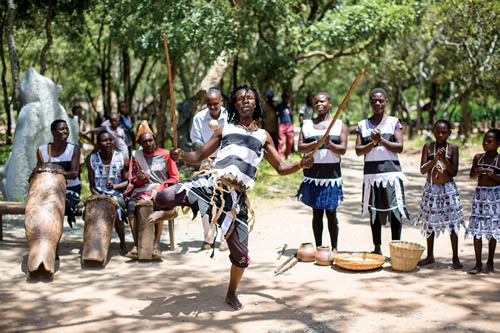
Tengenenge, Zimbabwe, one of the target sites of Japan's technical cooperation projects. The locals in this community entertain tourists by performing traditional dances. (Photography: Akihito Yoshida)
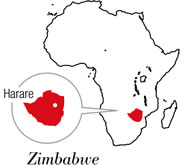
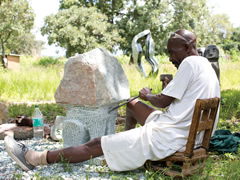
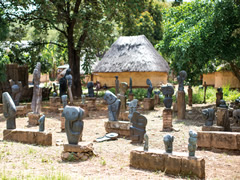
In Tengenenge, you can experience carving a
Shona stone sculpture. Works made by local
sculptors (right) are also on display.
(Photography: Akihito Yoshida)
Strengthening Cooperation in Tourism Development: Facing Common Challenges
The deep red dunes of the Namib, the world's oldest desert; the 108-meter Victoria Falls, one of the world's largest waterfalls; the Great Zimbabwe National Monument; and many other historical remnants built by humans. Southern Africa could be called a "gold mine of world heritage." All of these things come together to form the truly majestic picture we have of Africa. However, as of 2015, the number of tourists visiting Southern Africa only accounts for 2% of the international tourist market. As things stand, the abundant tourist attractions are not being fully utilized due to the lack of various elements that are essential to the tourism industry, including strategic marketing surveys, human resources with adequate skills, and transportation infrastructure such as airports and roads.
In response to this situation, the Regional Tourism Organisation of Southern Africa (RETOSA) was established in 1996 as a subordinate organization of the Tourism Committee of Southern African Development Community (SADC). Aiming at promoting cross-border tourism among tourists to Southern Africa, RETOSA has been working on joint development of tourism resources across national borders and developing a system where tourists can move between countries in the region without obtaining a visa. RETOSA has also attempted to solve the common challenges in Southern African countries, such as job creation, increasing income, and reducing inequality, from the perspective of tourism through the promotion of Community-Based Tourism (CBT). CBT is one of the tourism development approaches that provide the benefits to local communities. Since 2014, JICA has been dispatching Advisors for Sustainable Tourism Development and Regional Marketing in Southern Africa to RETOSA in order to support this initiative.
The three pillars of the activities of JICA advisors are: (1) formulating a CBT development strategy, (2) formulating a strategy for tourism marketing and promotion that primarily targets the Japanese market, and (3) strengthening the capabilities of the RETOSA secretariat. The "CBT Development Guidelines" has already been completed and published. For pillar (2), in order to find out how satisfied tourists were with their trip, a survey was conducted at South African airports targeting 300 tourists from Japan and other Asian countries. Guidelines were then created for the tourism promotion of the Southern African region to the East Asian tourist market based on the survey results. Yoshihito Urano, who was involved in the project as a JICA Project Formulation Advisor at the time, says, "The results of the survey revealed that there was a complete lack of tourist information on Southern Africa in Japan. So we made a strong effort into promotion activities for the Japanese market, including having RETOSA participate in Tourism EXPO Japan, one of the largest tourism events in Asia. It provided RETOSA representatives with an opportunity to deepen their understanding of the effectiveness of promotions based on the results of marketing surveys."
Community-Based Tourism Developed and Managed by Local Residents
Currently, various countries are pouring efforts into promoting CBT. One of those countries is Zimbabwe. Tourism projects, for example, management of facilities that introduce traditional culture were already run by local communities in about 150 areas in Zimbabwe with support from the government and other organizations. Since 2008, however, 90% of these local projects have been abandoned due to economic deterioration and other reasons. For two years starting in 2015, Japan carried out technical cooperation projects in Zimbabwe aiming at development of a master plan for implementing CBT and strengthening the capabilities of the Ministry of Tourism and Hospitality Industry (MOTHI) .
JICA advisors in RETOSA also cooperated in this project to select four sites through joint discussions between the Japanese expert team and MOTHI. In those four sites, tourism development that made use of the local resources in each community was implemented as a pilot project. Expert Kayo Murakami explains, "I was in charge of an area called ‘Chesvingo.' By taking advantage of its strategic location which is a 10-minute drive from the Great Zimbabwe National Monument, a UNESCO World Heritage Site, we targeted tourists from Europe and the United States and domestic students on field trips visiting the ruins."
Firstly workshops were held together with the local residents to prepare tourist routes utilizing local culture and nature. Murakami says she got a solid sense of the differences between Zimbabwe and Japan while working on the project. "We divided the local residents into several groups who prepared the routes while actually walking on them. To my surprise, one of the groups prepared a route that took seven hours. They said that it's normal in that area, to walk two hours one way to get to work, school, or shop." She also recalls another incident, "We asked a local artist to draw something on a map of the tourist routes, but the artist said he couldn't do it because he had never drawn on a small piece of paper such as A4 size. So we just photographed what he drew for us on a large sheet of paper, and then pasted the photo on an A4-sized sheet of paper with the size adjusted and reduced."
She also implemented training for local tour guides. Murakami narrates, "After visiting the Great Zimbabwe National Monument in the training, we had them experience the role of a tour guide via role playing. When I played the role of a foreign tourist, I tried to make huge reactions as much as possible to let them know the things that would interest and surprise foreigners." Through project activities such as trainings and workshops, the younger generation in the community discovered the value of tourism resources in their own area and began to be proud of them.
The goal is to promote tourism by attracting both visitors and local residents, while utilizing the rich nature and culture of Southern Africa.
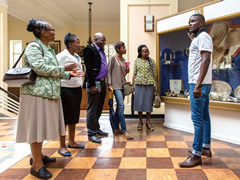
Inside the city hall of Bulawayo, the second largest city in Zimbabwe. The historical assets of Bulawayo and other items are displayed. (Photography: Akihito Yoshida)
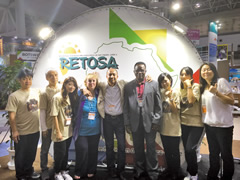
RETOSA representatives and their support team who took part in the exhibit at Tourism EXPO Japan. They were featured in Japanese media, making their participation an effective promotion.




scroll